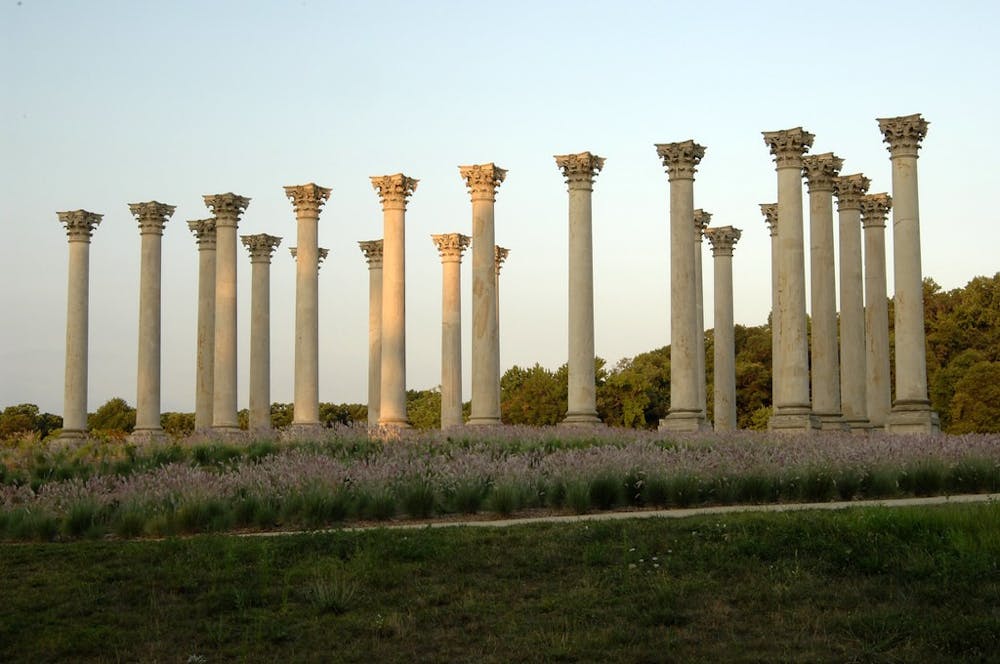The National Arboretum hosted events to teach gardening and Ikebana this April.
On April 27, Friends of the National Arboretum, a nonprofit organization that promotes the Arboretum, hosted a garden fair and plant sale at the Arboretum’s New York Avenue parking lot. Guests bought a variety of plants, art and clothing, and learned strategies for building a successful garden, according to the event’s signup page.
The fair and sale come after the D.C. chapter of Ikebana International hosted an Ikebana exhibit, showcasing the Japanese art of flower arrangement, at the Arboretum’s Bonsai Museum from April 13 until April 21.
Friends of the National Arboretum’s Garden Fair and Plant Sale
Attendees of the garden fair and plant sale purchased plants, gardening supplies, art, jewelry, decor, clothing and food from 41 companies, according to the Garden Fair and Plant Sale website.
The fair and sale opened from 9 a.m. until 4 p.m. on April 27. The plant sale opened to the public starting at 11 a.m., with those who held membership with the friend group able to attend the sale starting at 9 a.m.
Vendors sold a variety of plant types, according to Friends of the National Arboretum Executive Director Craven Rand. He said woody plants, annuals (which bloom in spring and die in winter) and perennials (which bloom and then regrow after the winter) were available for purchase.
People could also purchase rare plants collected by a member of the garden fair planning committee, Rand said.
“You can get just about anything at the garden fair,” Rand said. “It really just depends on what you’re looking for and what your garden’s about and what is pleasing to your eye.”
The event also included a workshop on raised garden beds hosted by hardware store W.S. Jenks & Son, according to its website.
Gardening education is a large part of the fair, according to Rand.
“We have experts there to teach people how to take care of them, what’s right for their garden and really just provide overall advice around gardening,” he said.
Part of the goal, Rand said, is for the National Arboretum to be a part of people’s gardening activities.
“Now’s the time to plant things in the garden,” Rand said. “So people are out there buying plants and trying to learn about how to improve their garden and we want to be with them to do that and spring is obviously the natural time.”
However, part of the goal is also to encourage people to explore the National Arboretum and its research, Rand said.
“It’s a wonderful time to be in the arboretum, obviously, because we have so many different kinds of plants and trees and shrubs, and spring’s one of the best times to view them,” Rand said. “So the more people we can bring out to the arboretum around that time, the better.”
The plant sale and garden fair is the second National Arboretum event the organization is hosting this April. On April 6, Friends of the National Arboretum hosted a poetry competition for children between ages 8 and 15. Charity Blackwell, a local spoken word artist, hosted the event.
“As an organization, we wanted to get more involved in the arts, and the arboretum — I feel like — is the perfect place for it,” Rand said.
With the garden fair and plant sale, Rand said the organization wants to bring more people to the arboretum and give them ideas for their spring activities.
“Just to walk through those tents and see some of those plants available; it might inspire somebody to take up gardening,” he said.
Ikebana International’s Annual Exhibit and Demonstrations
Earlier in the month, the National Arboretum was home to floral arrangements in different styles of the Japanese art of Ikebana, according to Ursula Kondo, president of Ikebana International Chapter 1. Each school of Ikebana has a different emphasis and history, according to the Chapter’s website.
Kondo said the event allowed her to explore her passion with people who may not have experienced it before.
“It’s really something special,” Kondo said. “You just don’t flow flowers into a vase and that’s it. You pay attention to each flower, to each branch, you bend it a little, you see what it could be like.”
Attendees learned about the different schools at the exhibits by asking questions and reading their informational displays, Kondo said.
“Some people come regularly every year to see it, but new people; they have no idea what Ikebana is,” Kondo said.
Motoko Shimizu, the chapter’s youth education committee chair and assistant treasurer, organized a kids workshop on Ikebana. She said she hoped the workshop taught kids about the arboretum and nature, and kindled friendship.
During the workshop, kids learned different methods of flower arrangement and explored the process of Ikebana, Shimizu said in an interview with The Eagle.
That process involves bending stems and experimenting with different designs for individual plants, Shimizu said.
“It really draws attention to the plants and nature and also the beauty of it,” she said.
Beyond the workshop, Kondo hopes the nine-day event taught people about Ikebana.
“It’s a meditative art,” Kondo said. “When we are doing our arrangements, we like to concentrate on what we are doing and to me, it is really very meditative.”
For Kondo, people visiting the arboretum for the exhibits allowed her to share her love for Ikebana with the public.
“I’m advertising what I have joy in doing; what really means something to me,” Kondo said.
This article was edited by Clair Sapilewski, Sara Winick and Abigail Turner. Copy editing by Luna Jinks, Leta Lattin and Charlie Mennuti.





